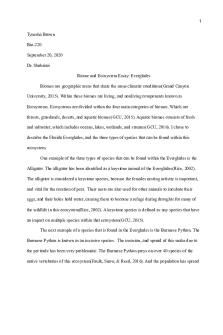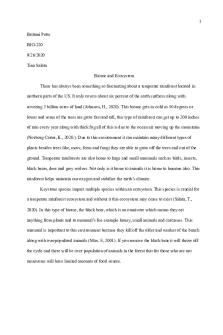Biome and Ecosystem Essay PDF

| Title | Biome and Ecosystem Essay |
|---|---|
| Author | Tynesha Brown |
| Course | Environmental Science |
| Institution | Grand Canyon University |
| Pages | 3 |
| File Size | 59.5 KB |
| File Type | |
| Total Downloads | 74 |
| Total Views | 164 |
Summary
Week 5 Assignment ...
Description
1 Tynesha Brown Bio-220 September 20, 2020 Dr. Shahriari Biome and Ecosystem Essay: Everglades Biomes are geographic areas that share the same climatic conditions(Grand Canyon University, 2015). Within these biomes are living, and nonliving components known as Ecosystems. Ecosystems are divided within the four main categories of biomes. Which are forests, grasslands, deserts, and aquatic biomes(GCU, 2015). Aquatic biomes consists of fresh and saltwater, which includes oceans, lakes, wetlands, and streams(GCU, 2016). I chose to describe the Florida Everglades, and the three types of species that can be found within this ecosystem. One example of the three types of species that can be found within the Everglades is the Alligator. The alligator has been identified as a keystone animal of the Everglades(Rice, 2002). The alligator is considered a keystone species, because the females nesting activity is important, and vital for the creation of peat. Their nests are also used for other animals to incubate their eggs, and their holes hold water, causing them to become a refuge during droughts for many of the wildlife in this ecosystem(Rice, 2002). A keystone species is defined as any species that have an impact on multiple species within that ecosystem(GCU, 2015). The next example of a species that is found in the Everglades is the Burmese Python. The Burmese Python is known as an invasive species. The invasion, and spread of this snake due to the pet trade has been very problematic. The Burmese Python preys on over 40 species of the native vertebrates of this ecosystem(Faulk, Snow, & Reed, 2016). And the population has spread
2 aggressively across most of the Everglades ecosystem(Faulk, Snow, & Reed, 2016). An invasive species is defined as any nonnative species that successfully displace native species for limited resources are classified as invasive or exotic species(GCU, 2015). The final animal that's a part of the Everglades we will discuss is the Florida Panther. The Florida pander is classified as an endangered species of this ecosystem. Due to decades of hunting, and displacement of their natural habitat, this subspecies of the cougar has been pushed close to extinction(Thompson & Gawrylewski, 2020). There are fewer than 100 Florida Panthers left, that's less than 5% of their original range. Endangered species are classified when there is concern about the genetic variety being limited(Meffe & Carroll, 1997). Although the Florida Everglades is a very vast and large ecosystem, there are still some species that can have a tremendous effect on this environment. From the key importance of the alligator, to the nuisance of the Burmese python, and finally the endangered Florida Panther. These species all serve their purpose.
3 References Falk Bryan G., Snow Ray W., & Reed Robert N. (2016). Prospects and Limitations of Citizen Science in Invasive Species Management : A Case Study with Burmese Pythons in Everglades National Park. Southeastern Naturalist, 15, 89. Grand Canyon University. (Ed.). (2015). Environmental science: The human impact on natural resources. Available from http://lc.gcumedia.com/bio220/environmental-science-thehuman-impact-on-natural-resources/v1.1/#/home Meffe, G., & Carroll, R. (1997). Principles of conservation biology (2nd ed.). Sunderland, MA: Sinauer Associates, Inc. Available from http://lc.gcumedia.com/bio220/environmentalscience-the-human-impact-on-natural-resources/v1.1/#/home Rice, K. G. (2002). Compilation of American alligator data sets in south Florida for restoration needs [electronic resource] / by Kenneth G. Rice. [Reston, Va.] : [Washington, D.C.] : U.S. Geological Survey ; National Park Service, 2002. Thompson, A., & Gawrylewski, A. (2020). Cat Tale: The Wild, Weird Battle to Save the Florida Panther. Scientific American, 322(3), 80....
Similar Free PDFs

Biome and Ecosystem Essay
- 3 Pages

Biome and Ecosystem Essay
- 4 Pages

Biome and Ecosystem Essay
- 4 Pages

Biome and ecosystem Essay
- 3 Pages

Biome and Ecosystem Essay
- 3 Pages

Biome and Ecosystem
- 5 Pages

Biome and Ecosystem
- 4 Pages

Biome and Ecosystem
- 5 Pages

BIO-220 Biome and Ecosytem Essay
- 4 Pages

Ecosystem report
- 15 Pages

Biome Chart
- 2 Pages
Popular Institutions
- Tinajero National High School - Annex
- Politeknik Caltex Riau
- Yokohama City University
- SGT University
- University of Al-Qadisiyah
- Divine Word College of Vigan
- Techniek College Rotterdam
- Universidade de Santiago
- Universiti Teknologi MARA Cawangan Johor Kampus Pasir Gudang
- Poltekkes Kemenkes Yogyakarta
- Baguio City National High School
- Colegio san marcos
- preparatoria uno
- Centro de Bachillerato Tecnológico Industrial y de Servicios No. 107
- Dalian Maritime University
- Quang Trung Secondary School
- Colegio Tecnológico en Informática
- Corporación Regional de Educación Superior
- Grupo CEDVA
- Dar Al Uloom University
- Centro de Estudios Preuniversitarios de la Universidad Nacional de Ingeniería
- 上智大学
- Aakash International School, Nuna Majara
- San Felipe Neri Catholic School
- Kang Chiao International School - New Taipei City
- Misamis Occidental National High School
- Institución Educativa Escuela Normal Juan Ladrilleros
- Kolehiyo ng Pantukan
- Batanes State College
- Instituto Continental
- Sekolah Menengah Kejuruan Kesehatan Kaltara (Tarakan)
- Colegio de La Inmaculada Concepcion - Cebu




